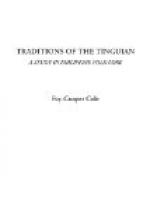The tales give constant sanction for the marriage of near relatives. Dumanau, we are told, marries his cousin [18], while we frequently meet with such statements as, “We are relatives and it is good for us to be married”, or “They saw that they were related and that both possessed magical power, so they were married (p. 35)”. It appears that a man may live with his sweetheart and have children by her, yet leave her, and, without reproach, marry another better fitted to be his wife (p. 54). He may also accept payment for a wife who has deserted him, apparently without loss of prestige (p. 64). No objection seems to be raised to a man having two wives so long as one of these is an inhabitant of the upper world (p. 111), but we find Kanag telling his former sweetheart that he cannot marry her since he is now married to another (p. 138). Again, when two women lay claim to Aponitolau, as their husband, they undergo a test and the loser returns to her former home (p. 94). However, this rule does not prevent a man from having several concubines (p. 120). Gawigawen, we are told, is accompanied to a pakalon by eighteen young girls who are his concubines (p. 59).
Divorce is twice mentioned, but it seems to call out protest only from the cast off wife (pp. 63, 149).
Closely associated with the celebration of a marriage seems to be a ceremony known as Sayang, during the progress of which a number of small structures—the largest known as balaua—are built. Judging by their names and descriptions, we are justified in considering them “spirit houses” as they are to-day.
The details of the extended Sayang ceremony are nowhere given, but so much is made plain:—At its beginning many people pound rice, for use in the offerings and for food, and da-eng [19] is danced (p. 40). After the Libon [20] invitations are sent out, by means of betel-nuts covered with gold, to those whose presence is especially desired (p. 62). When the guests arrive at the village spring or gate they are offered food or drink, and then while they dance they are sprinkled with water or rice, after which all go up to the town (p. 41 note 2). A medium who knows the customs and desires of the spirits constructs a bamboo mat, which is known as talapitap, and on it offers food. To call their attention she frequently strikes the ground with the dakidak—split sticks of bamboo and lono [21] (p. 40). The guests are not neglected, so far as regards food, for feasting and dancing occupy a considerable portion of their time. The ceremonial dance da-eng is mentioned, but the tadek [22] seems to be the one in special favor (pp. 41, 59).
One tale tells us that the Sayang was held immediately following a head hunt; and another, that Aponitolau went out to get the head of an old man before he started this ceremony (pp. 69, 76); however, the evidence is by no means conclusive that it is related to warfare.




